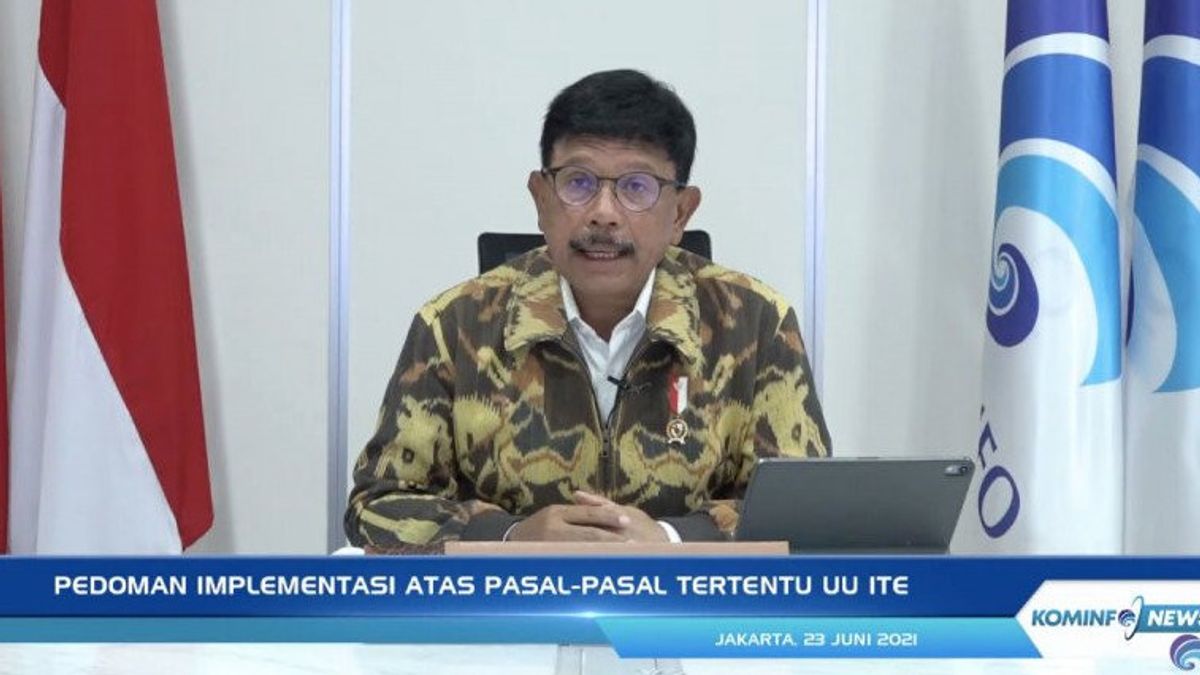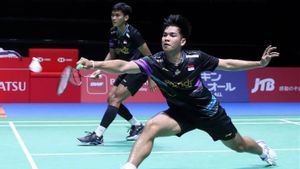JAKARTA - The Minister of Communication and Information (Menkominfo) Johnny G Plate announced a Joint Decree (SKB) Guidelines for the Implementation of Certain Articles which is often called the "Rubber Article" in the Electronic Information and Transaction Law.
Johnny said the government through the Coordinating Minister for Political, Legal and Security Affairs listened to and paid attention to public opinion. Including those from academia, civil society organizations, the press, and those who report and are reported on the basis of the ITE Law.
"This is an implementation guideline as a handbook for law enforcement officers from elements of the Ministry of Communication and Informatics, the Indonesian National Police and the Attorney General's Office," said Johnny G. Plate during a virtual conference, Wednesday, June 23.
The SKB was signed by the Minister of Communication and Information, the National Police Chief and the Attorney General, containing an explanation of the definitions, requirements and linkages with other laws and regulations for articles that are often in the public spotlight.
"These articles are also often used and are crucial for Law Enforcement Officials (APH)," added Johnny.
These Implementation Guidelines highlight eight articles in Law Number 11 of 2008, which were revised in Law Number 19 of 2016 concerning Amendments to Law Number 11 of 2008 concerning Information and Electronic Transactions or better known as the ITE Law.
The first guideline, Article 27 paragraph (1) regarding electronic content that violates decency, focuses on activities to actively distribute, disseminate and transmit decency content, through uploading or transmitting decency content, not on immoral acts.
The definition of decency must be in accordance with Law Number 44 of 2008 concerning Pornography and/or Articles 281 and 282 of the Criminal Code.
Second, the guidelines for Article 27 paragraph (2) regarding gambling content, focuses on the distribution, dissemination and delivery of gambling content, whether in the form of applications, accounts, advertisements, sites and/or billing systems for dealers in the form of videos, images, sound or writing.
Third, the guidelines for Article 27 paragraph (3) regarding the content of insults and defamation. The definition of insult and defamation refers to the provisions of Articles 310 and 311 of the Criminal Code.
"The reporter must be an individual with a specific identity, not an institution, corporation, profession or position. This article focuses on the act of distributing, distributing and sending content to the public, which is done intentionally, not on the feelings of the victim," wrote the SKB Implementation of the ITE Law.
Fourth, the guidelines of Article 27 paragraph (4) regarding extortion and threatening content, focus on distribution activities, sending threatening content which includes threats of disclosure of secrets, dissemination of personal data, photos or videos.
"Extortion or threats in question are coercive, with the aim of benefiting themselves economically, to provide goods, create debts, write off receivables belonging to the person being threatened."
Fifth, the guidelines for Article 28 paragraph (1) regarding fake news that harm consumers, that this article is not a punishment for hoaxes, but online trading. This article relates to Law Number 8 of 1999 concerning Consumer Protection.
Sixth, Article 28 paragraph (2) regarding content that spreads hatred based on SARA, the apparatus must be able to prove that the delivery of the content invites or incites the public to be hostile to certain individuals or groups.
Seventh, the guideline of Article 29 regarding the content of frightening with violence, that punishment is carried out for the act of sending information containing threats that have the potential to be realized and showing the intention to harm the victim by physically or psychologically violence.
The handling of articles must be supported by witnesses who show the fact that the victim is experiencing fear/psychological pressure.
Eighth, the guidelines for Article 36 concerning the weighting of sanctions due to losses caused by criminal acts of the ITE Law. Regulated losses are material losses with a value that must be calculated and determined at the time of reporting.
"For the value of material losses, refer to the Supreme Court Regulation No. 2 of 2012 concerning Adjustment of Limits for Minor Crimes and the Amount of Fines in the Criminal Code."
The Guidelines for the Implementation of Certain Articles in the ITE Law, according to Johnny, support the enforcement of the ITE Law, as a special provision of criminal norms/lex specialis, which prioritizes the application of restorative justice so that the settlement of problems with the ITE Law can be carried out without having to go through a judicial mechanism.
This effort needs to be made to strengthen the position of criminal justice provisions as the ultimum remidium, or the last option in solving legal problems.
The English, Chinese, Japanese, Arabic, and French versions are automatically generated by the AI. So there may still be inaccuracies in translating, please always see Indonesian as our main language. (system supported by DigitalSiber.id)













